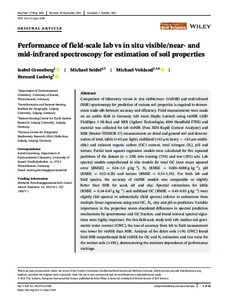| dc.date.accessioned | 2022-02-16T14:14:39Z | |
| dc.date.available | 2022-02-16T14:14:39Z | |
| dc.date.issued | 2021-10-10 | |
| dc.identifier | doi:10.17170/kobra-202201255613 | |
| dc.identifier.uri | http://hdl.handle.net/123456789/13629 | |
| dc.description.sponsorship | Gefördert im Rahmen des Projekts DEAL | ger |
| dc.description.sponsorship | Deutsche Forschungsgemeinschaft, Grant/Award Numbers: LU 583/19-1, VO 1509/7-1 | |
| dc.language.iso | eng | eng |
| dc.rights | Attribution-NonCommercial-NoDerivatives 4.0 International | * |
| dc.rights.uri | http://creativecommons.org/licenses/by-nc-nd/4.0/ | * |
| dc.subject | carbon fractions | eng |
| dc.subject | handheld | eng |
| dc.subject | labile carbon | eng |
| dc.subject | mid infrared | eng |
| dc.subject | near infrared | eng |
| dc.subject | partial least squares regression | eng |
| dc.subject | portable | eng |
| dc.subject | soil organic carbon | eng |
| dc.subject | soil spectroscopy | eng |
| dc.subject | stabilized carbon | eng |
| dc.subject.ddc | 570 | |
| dc.subject.ddc | 600 | |
| dc.title | Performance of field-scale lab vs in situ visible/near- and mid-infrared spectroscopy for estimation of soil properties | eng |
| dc.type | Aufsatz | |
| dcterms.abstract | Comparison of laboratory versus in situ visible/near- (visNIR) and mid-infrared (MIR) spectroscopy for prediction of various soil properties is required to demonstrate trade-offs between accuracy and efficiency. Field measurements were made on an arable field in Germany (silt loam Haplic Luvisol) using visNIR (ASD FieldSpec 3 Hi-Res) and MIR (Agilent Technologies 4300 Handheld FTIR) and material was collected for lab visNIR (Foss XDS Rapid Content Analyzer) and MIR (Bruker-TENSOR 27) measurements on dried and ground soil and determination of total, labile (>63 μm light), stabilized (>63 μm heavy + <63 μm oxidizable) and resistant organic carbon (OC) content, total nitrogen (Nt), pH and texture. Partial least squares regression models were calculated for five repeated partitions of the dataset (n = 238) into training (75%) and test (25%) sets. Lab spectral models outperformed in situ models for total OC (root mean squared error [RMSE] = 0.24–1.0 g kg−¹), Nt (RMSE = 0.026–0.088 g kg−¹), pH (RMSE = 0.12–0.28) and texture (RMSE = 0.53–1.5%). For both lab and field spectra, the accuracy of visNIR models was comparable or slightly better than MIR for sand, silt and clay. Spectral estimations for labile (RMSE = 0.34–0.47 g kg−¹) and stabilized OC (RMSE = 0.41–0.85 g kg−¹) were slightly (lab spectra) to substantially (field spectra) inferior to estimations from multiple linear regressions using total OC, Nt, clay and pH as predictors. Variable importance in the projection scores elucidated differences in spectral prediction mechanisms by spectrometer and OC fraction, and found mineral spectral signatures were highly important. For this field-scale study with 14% median soil gravimetric water content (GWC), the loss of accuracy from lab to field measurement was lower for visNIR than MIR. Analysis of the driest soils (<9% GWC) found field MIR outperformed field visNIR for OC and Nt estimation and vice versa for the wettest soils (>18%), demonstrating the moisture dependence of performance rankings.
Highlights
- Lab vs field visible/near- (visNIRS) and mid-infrared (MIRS) spectroscopy require comparison for prediction of soil C fractions, N, pH and texture.
- Lab MIRS prediction of C, N and pH were superior, while texture estimations were comparable or slightly inferior to lab visNIRS.
- At 14% median soil water content, the loss of accuracy from lab to field measurement was lower for visNIRS than MIRS.
- The ranking of field visNIRS vs MIRS performance for C and N estimation is moisture dependent. | eng |
| dcterms.accessRights | open access | |
| dcterms.creator | Greenberg, Isabel | |
| dcterms.creator | Seidel, Michael | |
| dcterms.creator | Vohland, Michael | |
| dcterms.creator | Ludwig, Bernhard | |
| dc.relation.doi | doi:10.1111/ejss.13180 | |
| dc.relation.projectid | Grant Numbers: LU 583/19-1, VO 1509/7-1 | |
| dc.subject.swd | Kohlenstoff | ger |
| dc.subject.swd | MIR <Physik> | ger |
| dc.subject.swd | NIR-Spektroskopie | ger |
| dc.subject.swd | Methode der partiellen kleinsten Quadrate | ger |
| dc.subject.swd | Transportables Gerät | ger |
| dc.subject.swd | Physikochemische Bodeneigenschaft | ger |
| dc.type.version | publishedVersion | |
| dcterms.source.identifier | eissn:1365-2389 | |
| dcterms.source.issue | Issue 1 | |
| dcterms.source.journal | European Journal of Soil Science (EJSS) | eng |
| dcterms.source.volume | Volume 73 | |
| kup.iskup | false | |
| dcterms.source.articlenumber | e13180 | |


